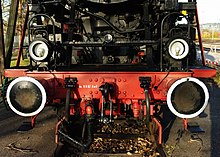Headstock (rolling stock): Difference between revisions
Peter Horn (talk | contribs) →Length over headstocks: An alternative expression → Alternative expressions etc |
Citation bot (talk | contribs) Removed parameters. | Use this bot. Report bugs. | Suggested by Eastmain | #UCB_webform 641/647 |
||
| (One intermediate revision by one other user not shown) | |||
| Line 1: | Line 1: | ||
{{Other uses|Headstock (disambiguation)}} |
{{Other uses|Headstock (disambiguation)}} |
||
[[File:Lokomotive 85007 22.jpg|thumb|Buffer beam / headstock (painted red) fitted with [[buffers and chain coupler]] and air hoses on the front end of a German [[steam locomotive]]]] |
[[File:Lokomotive 85007 22.jpg|thumb|Buffer beam / headstock (painted red) fitted with [[buffers and chain coupler]] and air hoses on the front end of a German [[steam locomotive]]]] |
||
A '''headstock''' of a [[Railroad car|rail vehicle]] is a transverse structural member located at the extreme end of the vehicle's underframe. The headstock supports the [[railway coupling|coupling]] at that end of the vehicle, and may also support [[Buffer (rail transport)|buffers]], in which case it may also be known as a '''buffer beam'''.<ref name=rtwp>{{cite web|title=Glossary|url=http://www.railway-technical.com/newglos.shtml#H|work |
A '''headstock''' of a [[Railroad car|rail vehicle]] is a transverse structural member located at the extreme end of the vehicle's underframe. The headstock supports the [[railway coupling|coupling]] at that end of the vehicle, and may also support [[Buffer (rail transport)|buffers]], in which case it may also be known as a '''buffer beam'''.<ref name=rtwp>{{cite web|title=Glossary|url=http://www.railway-technical.com/newglos.shtml#H|work=Railway Technical Web Pages|access-date=29 August 2012|url-status=dead|archive-url=https://web.archive.org/web/20141007220720/http://www.railway-technical.com/newglos.shtml#H|archive-date=7 October 2014}}</ref> The headstocks form part of the [[underframe]] of a [[locomotive]] or a [[railroad car]]. The headstocks of [[locomotives]], [[railcar]]s and [[Control car (rail)|cabcars]] also support [[Locomotive headlamp|headlamps]] and the [[Hose (tubing)|hoses]] for [[Railway air brake|air brakes]], [[vacuum brake]]s as well as the [[Electrical cable|cables]] for [[Push–pull train|train control]] and [[head end power]]. |
||
== Length over headstocks == |
== Length over headstocks == |
||
| Line 17: | Line 17: | ||
* [[Glossary of rail transport terms]] |
* [[Glossary of rail transport terms]] |
||
* [[Glossary of steam locomotive components]] |
* [[Glossary of steam locomotive components]] |
||
* [[Pilot (locomotive) |
* [[Pilot (locomotive attachment)]] (cowcatcher) |
||
{{div col end}} |
{{div col end}} |
||
Latest revision as of 16:16, 15 July 2024

A headstock of a rail vehicle is a transverse structural member located at the extreme end of the vehicle's underframe. The headstock supports the coupling at that end of the vehicle, and may also support buffers, in which case it may also be known as a buffer beam.[1] The headstocks form part of the underframe of a locomotive or a railroad car. The headstocks of locomotives, railcars and cabcars also support headlamps and the hoses for air brakes, vacuum brakes as well as the cables for train control and head end power.
Length over headstocks
[edit]A commonly used measurement relating to a rail vehicle is its length over headstocks, which is the length of the vehicle excluding its couplings or buffers (if any).[2] Alternative expressions for length over headstocks are length over coupler pulling faces, usually applied to Janney couplers, and length over buffers.
See also
[edit]References
[edit]- ^ "Glossary". Railway Technical Web Pages. Archived from the original on 7 October 2014. Retrieved 29 August 2012.
- ^ Ellis, Iain (2006). Ellis' British Railway Engineering Encyclopaedia. Raleigh, North Carolina: Lulu.com. p. 196. ISBN 1847286437.
